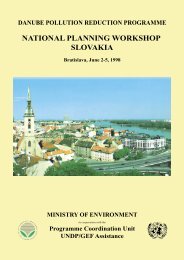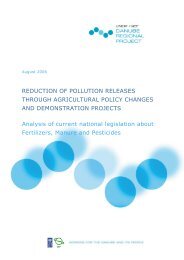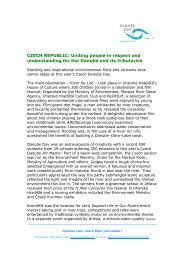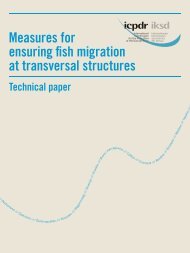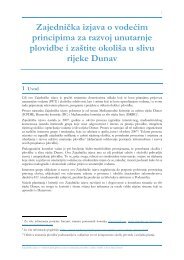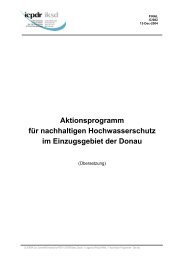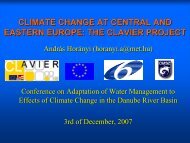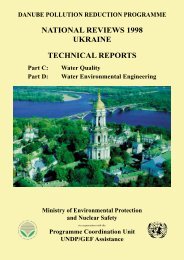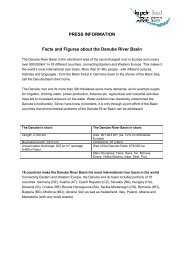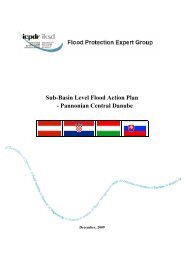Final Report - ICPDR
Final Report - ICPDR
Final Report - ICPDR
Create successful ePaper yourself
Turn your PDF publications into a flip-book with our unique Google optimized e-Paper software.
2 Background and objectives<br />
Several (acute and chronic) accident pollution happened in the Tisza River during the<br />
year of 2000 due to industrial activities in the upper (Ukrainian and Romanian)<br />
watershed. Reliable and comparable information on chemical and biological status is<br />
necessary in order to describe the effect of the pollution events, and to compare the<br />
present pollution level to any future post-pollution situation.<br />
German and Hungarian scientists agreed to perform the “Investigation of the Tisza<br />
River (ITR)” to study the environmental effects of the acute cyanide pollution and<br />
frequent chronic heavy metal pollution accidentally occurring in the Tisza River Basin.<br />
The ITR program followed directly the Joint Danube Survey (JDS) organised by the<br />
MLIM EG of the International Commission for the Protection of the Danube River<br />
(<strong>ICPDR</strong>) after it was finished in the Danube Delta on the 20th of September 2001. The<br />
overall objective of the ITR was to undertake a longitudinal ship survey of the Tisza<br />
River to produce comparable and reliable information on the quality of different<br />
compartments of the aqueous ecosystem (sediment, suspended solids, mussel,<br />
macroinvertebrate and fish species) with focus on chemical and biological<br />
determinands.<br />
Earlier national monitoring program was performed in Hungary between 2000 and 2002<br />
sponsored by the Hungarian Ministry of Environment. The purpose of the study was to<br />
describe the acute effect of the cyanide and heavy metal pollutions together with the<br />
investigation of further effects of the polluting compounds on the aquatic environment.<br />
Seasonal investigations were performed on the macroinvertebrates and detailed<br />
analysis was done on the heavy metal pollution of the sediment fraction after the main<br />
Tisza flooding period of the Tisza in April 2000. Data collected during that period are<br />
ready for comparison of the present ITR in order to describe the environmental effects<br />
on this short time scale.<br />
VITUKI Plc, Budapest, Hungary in co-operation with the Hydrometeorological Institute,<br />
Belgrade, Federal Republic of Yugoslavia, performed a special sampling program<br />
„Study on Bioindicators, Inorganic and Organic Micropollutants in Selected Bioindicator<br />
Organism in the River Danube” during the summer period of 2000. It was a follow-up<br />
activity after the UNEP/OCHA Balkan Task Force Mission, which investigated the<br />
environmental impacts of the Kosovo conflict in FRY in 1999. The major aim of the<br />
Study on Bioindicators was to investigate the presence and accumulation of organic<br />
and inorganic micropollutants in sediments and biota and to analyse the<br />
macrozoobenthos in the Danube reach and its main tributaries impacted by the Kosovo<br />
conflict. The Study was financially supported by the governments of Germany and<br />
Austria and organized by the Secretariat of the <strong>ICPDR</strong>. The collected data on<br />
micropollutant compounds are available for comparison in case of the ITR results, as<br />
well.<br />
The intention of the JDS - ITR project was to use the same sampling and laboratory<br />
expertise that had been applied for the JDS expedition, and, in the Danube countries,<br />
as well. Additionally, it seemed to be useful to use the same resources that have the<br />
necessary level of analytical instrumentation and operate with proven acceptable<br />
AQC procedures. Therefore the goals of the ITR survey were as same as for the<br />
JDS:<br />
4



